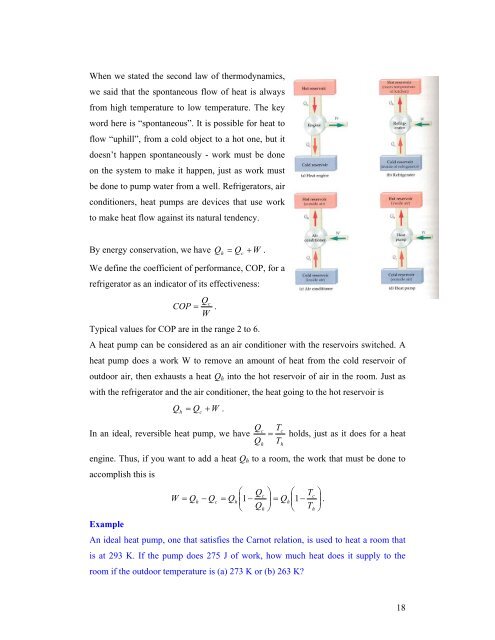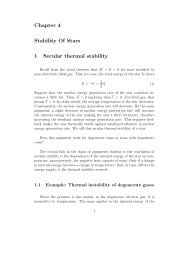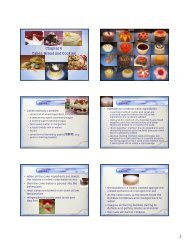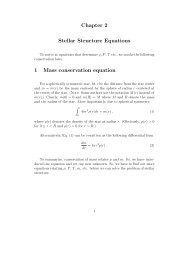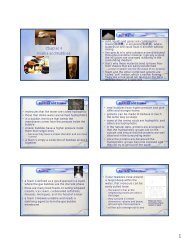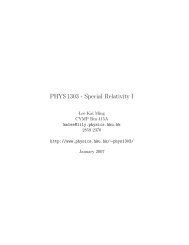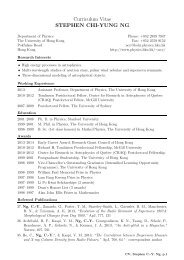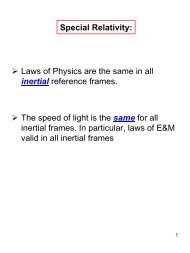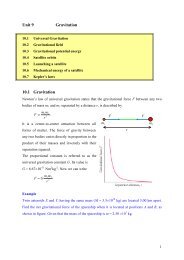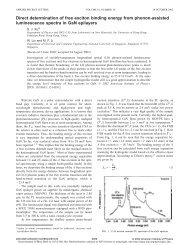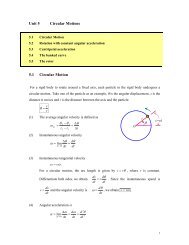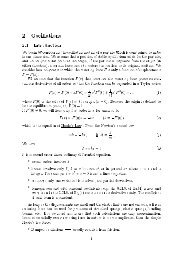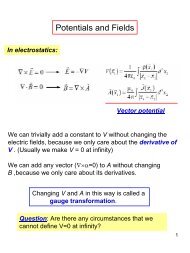Thermal Behavior of Matter and Heat Engines - Department of ...
Thermal Behavior of Matter and Heat Engines - Department of ...
Thermal Behavior of Matter and Heat Engines - Department of ...
You also want an ePaper? Increase the reach of your titles
YUMPU automatically turns print PDFs into web optimized ePapers that Google loves.
When we stated the second law <strong>of</strong> thermodynamics,<br />
we said that the spontaneous flow <strong>of</strong> heat is always<br />
from high temperature to low temperature. The key<br />
word here is “spontaneous”. It is possible for heat to<br />
flow “uphill”, from a cold object to a hot one, but it<br />
doesn’t happen spontaneously - work must be done<br />
on the system to make it happen, just as work must<br />
be done to pump water from a well. Refrigerators, air<br />
conditioners, heat pumps are devices that use work<br />
to make heat flow against its natural tendency.<br />
By energy conservation, we have Q<br />
= Q W .<br />
h c<br />
+<br />
We define the coefficient <strong>of</strong> performance, COP, for a<br />
refrigerator as an indicator <strong>of</strong> its effectiveness:<br />
Qc<br />
COP = .<br />
W<br />
Typical values for COP are in the range 2 to 6.<br />
A heat pump can be considered as an air conditioner with the reservoirs switched. A<br />
heat pump does a work W to remove an amount <strong>of</strong> heat from the cold reservoir <strong>of</strong><br />
outdoor air, then exhausts a heat Q h into the hot reservoir <strong>of</strong> air in the room. Just as<br />
with the refrigerator <strong>and</strong> the air conditioner, the heat going to the hot reservoir is<br />
Q<br />
= Q W .<br />
h c<br />
+<br />
In an ideal, reversible heat pump, we have<br />
Q<br />
c<br />
T =<br />
c holds, just as it does for a heat<br />
engine. Thus, if you want to add a heat Q h to a room, the work that must be done to<br />
accomplish this is<br />
⎛ Q ⎞ ⎛ ⎞<br />
= − =<br />
⎜ −<br />
c<br />
T<br />
⎟ =<br />
⎜ −<br />
c<br />
W Q<br />
⎟<br />
h<br />
Qc<br />
Qh<br />
1 Qh<br />
1 .<br />
⎝ Qh<br />
⎠ ⎝ Th<br />
⎠<br />
Example<br />
An ideal heat pump, one that satisfies the Carnot relation, is used to heat a room that<br />
is at 293 K. If the pump does 275 J <strong>of</strong> work, how much heat does it supply to the<br />
room if the outdoor temperature is (a) 273 K or (b) 263 K?<br />
Q<br />
h<br />
T<br />
h<br />
18


